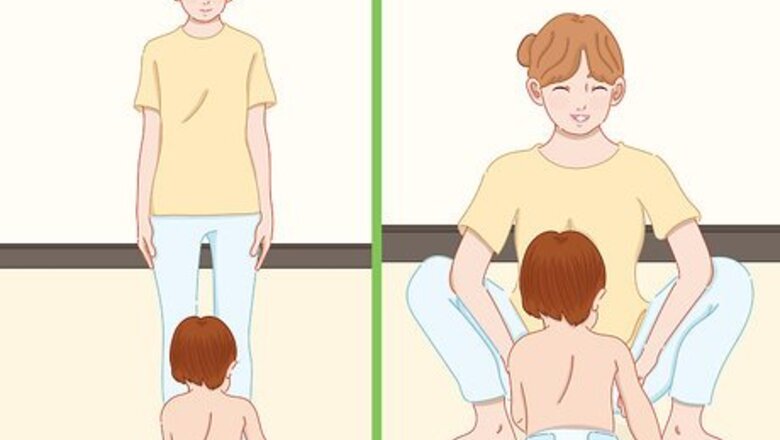
views
Picking up a Toddler Safely
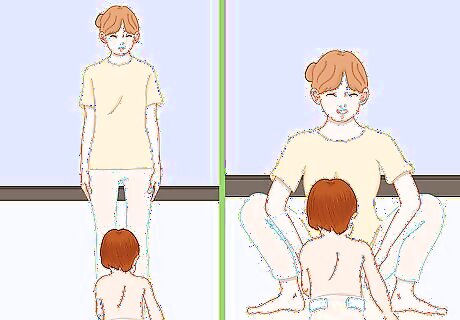
Stand in front of your toddler and squat down. Position yourself so that your legs are about shoulder-width apart, and squat down to be about eye-level with them. Keep your back and neck straight and relaxed. If you feel unstable while squatting, put one knee on the ground to steady yourself. Never bend at the waist to pick up your toddler. This can cause unnecessary strain on your back and makes lifting much more difficult.

Place one arm around their back and the other just below their backside. Keep your head facing forward as you bring them to your chest. Secure their back and legs, positioning them on your body for when you'll pick them up. Reaching out to pick them up can strain your back. Never lift a child from their armpits, which can be painful for them and you. Avoid lifting up a child by their forearms or hands, as this can cause an injury known as “nursemaid's elbow.”

Use the muscles in your legs to stand and lift them off of the ground. Engage your leg and core muscles to slowly return to a standing position. Be sure to keep your back straight, and hold the toddler close to your body as you're standing up. If you can, ask your toddler to hold onto you with their arms on your shoulders and legs around your waist awhile you stand. This will help keep them in place, and will allow you to use one of your hands to stabilize yourself with a wall or piece of furniture if necessary. Try to avoid twisting your back or torso while standing, which can cause an injury.

Hold them close to you, at the front of your body. The easiest way to carry a toddler is at the front of your body, with their weight resting on your chest and arms. Keep your arms around their back and under their backside. Having your child face backwards over your shoulder is a great position to soothe a toddler who is getting ready for nap time or bedtime. You can face your toddler forwards by supporting under the toddler’s bottom with one hand and putting your other hand across their chest. This position is great for playing with a toddler by pretending they are driving a car or flying an airplane. For extra support, ask your toddler to hold onto you with their legs. If possible, try to keep them from wrapping their arms around your neck, which can cause you to bend forward. If you need to shift your toddler to one side, wait until you're in a standing position, and use your arms to move them. Avoid twisting your back or torso to shift them to your side.
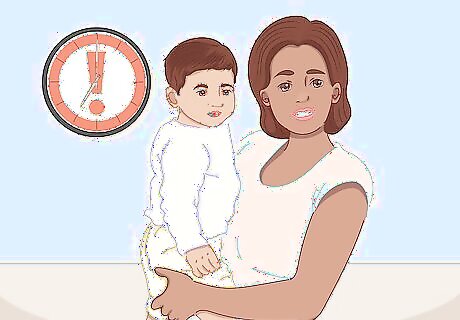
Avoid carrying them on one side of your body for long periods of time. Some parents develop hip problems from carrying their toddler on one hip. Keep your toddler at the front of your body whenever possible, and switch between hips every few minutes if you do need to hold your toddler to the side. The advantage of carrying your toddler on your hip is that it's easy to gently rock the toddler by swaying back and forth. Remember to use your arms, rather than your back or torso, to move your toddler from one side to another. Expert Answer Q How do you hold your child on your lap? Jessie Davidson Jessie Davidson Child Care Specialist Jessie Davidson is a Child Care Specialist and the CEO and Founder of BabysitPro, which provides online courses for current and aspiring babysitters. Jessie has over 20 years of childcare experience and specializes in best practices for sitters of infants, toddlers, preschoolers, and grade-schoolers. BabysitPro’s courses are unique and age-specific so babysitters can learn detailed information relevant to the children they babysit. Jessie holds a BA in French Studies from Wheaton College and an MA in Visual Anthropology from The University of Southern California. Jessie Davidson EXPERT ADVICE Answer from Jessie Davidson: When you sit down, resituate the toddler by facing them toward you, keeping them steady by holding them under the arms, around the waist, or by their hands. Then, move your knees up and down to gently bounce the toddler. Feel free to talk, sing, or make funny faces while you do this.
Securing a Toddler with a Sling

Try on a few slings before purchasing one that is safe and comfortable. When searching for a sling at a specialty store or supermarket, look for a sling with a metal ring and sturdy fabric, such as cotton, wool, or tri-blend. Be sure to check the packaging and make sure your toddler is within the height and weight limit. If you're able to, try on the sling in the store with your toddler in it. As a general rule, a well-fitting sling will be tight, and you will be able to look down and see that your toddler is close enough for you to kiss them. Their back should be well-supported and their head should be up with their chin off of their chest. Bring your toddler to the store with you and try out several slings with them to find the one that is the most comfortable for you both.

Hold the ring of the sling with your non-dominant hand. Pick up the sling in your non-dominant hand as you hold the toddler to one side with your dominant arm. Make sure they're secure and in a comfortable position while you're getting ready to put the sling on. If your toddler is squirmy or doesn't want to be held, wait until they calm down to put on the sling. You'll only have one arm available to hold them, which can be dangerous if they're trying to get to the ground.

Put the ring over your head and onto the shoulder of your dominant hand. Position the sling so that it's draped across your body like a sash. The ring should be on the same side of your body as the toddler, while the bulk of the fabric rests on the opposite hip. Using this technique, your toddler will be positioned on the side of your non-dominant hand, leaving your dominant hand free. If you'd prefer to have your non-dominant hand free, place the ring on that shoulder.
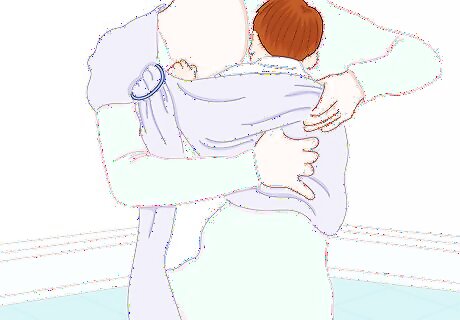
Shift the toddler to the side of your body where the fabric of the sling is resting. Using your arms, move the toddler across your body to the side where the fabric is resting. The fabric should dip below their backside, and their legs should be positioned in front of the fabric on the front of your body. Try to keep both of your toddler's legs in front of your body to make positioning the sling easier. Once they're in the sling, they can adjust their legs to a position that is more comfortable.

Reach your dominant hand through the sling and pull their feet through. Slide your hand under the fabric on the front of your body, and reach under your toddler's legs to pull the fabric out from underneath their body, and position it behind their backside. Use your non-dominant arm to help guide their legs through the loop in the fabric. If your toddler isn't cooperating with this step, try slipping the fabric under one leg and then the other, rather than both at the same time. Try to keep the fabric bunched while you're sliding it out from under the toddler. This will make the process easier and prevent you and your toddler from getting tangled in the fabric.
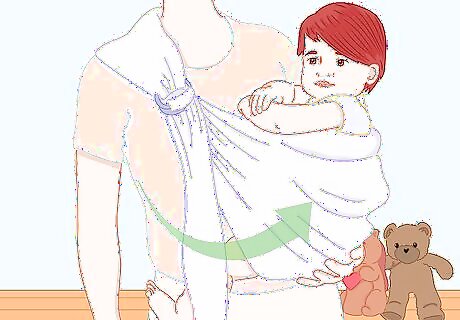
Use your hands to spread the fabric from the toddler's knees to their back. Once the sling is wrapped around both of you, pull the fabric up your toddler's back until it's just below their shoulder blades. Make sure the bottom portion is positioned behind their knees to offer the most support. Leave the bottom half of your toddler's legs and feet outside of the sling so they can find a comfortable position.

Tighten the sling by pulling the excess fabric through the ring. To make sure your toddler is secure, tug on the end of the fabric outside of the ring. Pull it forward, upward, and down until you feel that your toddler is close to your body and secure in the sling. If you feel your toddler coming loose as you walk, pull on the end of the fabric to re-tighten the sling.
Using a Back Carrier

Read the instructions for the carrier to ensure that you're using it correctly. Before placing your toddler in a carrier, take a look at the directions. Make sure you know the proper way to position the carrier, and where your toddler is supposed to sit. The instructions can also include helpful tips for getting a comfortable fit and walking with the extra weight of a toddler on your back. There are a few different types of carriers. A carrier for hiking will require a different position than one for day-to-day use. It's best to try out several carriers with the toddler in the store before selecting one.

Fasten the carrier around your waist and tighten it with the strap. Wrap the bottom of the carrier around your waist and push the buckle together until you hear a click. Then, pull the strap until the carrier is snug, but not too tight, around your waist. If the strap feels too tight, pull on the buckle to loosen it.
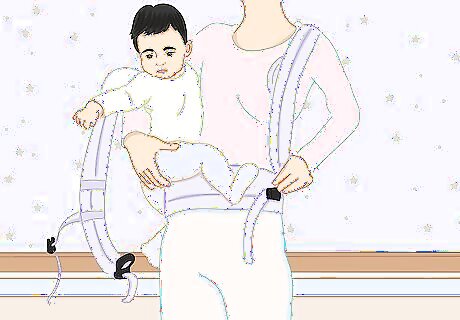
Put on one shoulder strap and pick up the toddler. Slip one of the straps over your shoulder, and then lift your toddler as normal. Use your arms to position them with the side of your body without a shoulder strap. Make sure the toddler has one leg in front of your body and one behind it. Try not to twist your torso or back as you're moving the toddler. You can loosen the carrier or strain your back with too much movement.
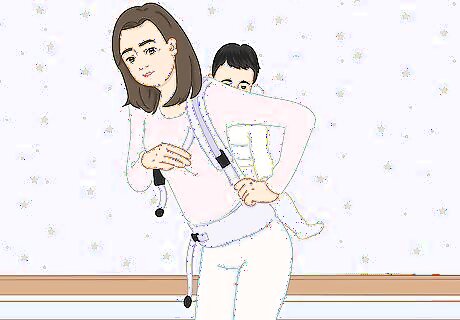
Lean forward and move the child between the carrier and your back. While you're bending at the waist, slowly push the child onto your back. Pull one of their legs to the side of the carrier with the strap on your shoulder as you move them with your free arm. Make sure their leg is through the hole on the strap side of the carrier. It may be helpful to ask the child to hold onto your shoulders or neck for stability as you move them. They might also be able to put their leg in the carrier while you guide them.

Put on the other strap, and adjust their position using your hands. Pull the other strap over your shoulder, and make sure their legs are on out of the carrier on either side of your body. Use your hands to smooth the panel along their back, and bounce them slightly to move them higher onto your back. Many parents prefer to carry their toddlers higher on their backs because the extra weight is easier to manage. Try various different positions to see what's most comfortable for you.
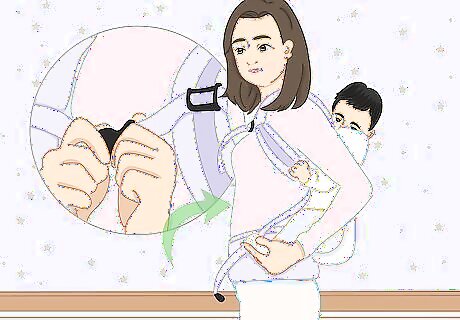
Secure the front strap and stand up straight. Buckle the strap in front of your chest and tug on the strap to tighten it. Then, slowly straighten your back to shift the toddler's weight into the carrier. The lower strap of the carrier should be secure around your waist, and should hit just below the toddler's backside. If they're lower in the carrier when you stand, lean over again and bounce them a few times to push them higher on your back. Then, tighten the waist strap and stand up.
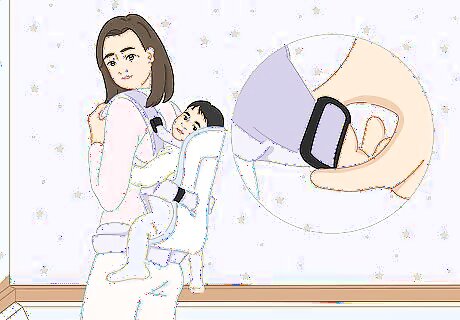
Use the shoulder straps to adjust the position of the toddler on your back. When you're standing, pull on the loose ends of the shoulder straps to tighten them and bring the toddler closer to your back. If you want them to lean away from your back slightly, pull on the buckles to loosen the straps. As you walk, you may need to tighten or loosen the shoulder and chest straps. Never unbuckle the waist belt when your toddler is in the carrier, as this can cause them to slip out of the carrier.



















Comments
0 comment